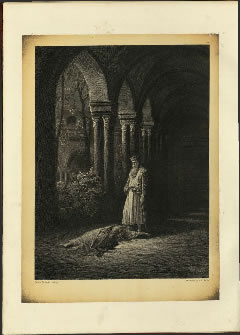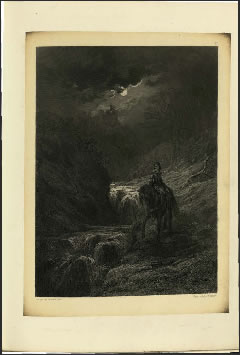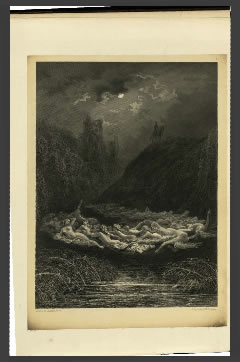The Story of Arthur and Guinevere and the fate of Sir Lancelot of the Lake
You may click on the thumbnail images to view them full screen
Alfred, Lord Tennyson, The Story of Arthur and Guinevere and the fate of Sir Lancelot of the Lake as told in Antique Legends and Ballads, and in Modern Poetry, with 9 illustrations by Gustave Doré. [London: Moxon, Son and co, 1879]
The influence of Alfred, Lord Tennyson's poetic retelling of the Arthurian legend on generations of Victorian readers and beyond is well known. Tennyson's poetry celebrates the age of chivalry and its finest example, Arthur, from a typical Victorian perspective, hailing manhood and blaming female agency for the destruction of the Round Table. These fine examples of the history of printing Arthurian literature bear witness to the melancholic and entrancing quality of both Tennyson's poetry and Doré's illustrations.
Gustave Doré (1832-83) was one of the most prolific and successful book illustrators of the nineteenth century. Among other projects, he illustrated the works of famous classical (Dante, Rabelais) and contemporary authors (Balzac, Milton, Coleridge).
This is a copy of the first Idyll Tennyson published (one of the four planned Idylls focusing on female characters: Enid, Elaine, Vivien and Guenevere), 'The Story of Guenevere'. This edition also includes Tennyson's poem on the 'Birth of Arthur', in which Tennyson removed the stain of incest from Arthur's conception by telling a story in which Arthur is found as a baby abandoned on a beach.
 The King's Farewell: A remorseful Guinevere lies at King Arthur's feet in Almesbury as he expresses his emotions at her betrayal, ending the speech by saying, '"But hither shall I never come again,/Never lie by thy side; see thee no more—/Farewell!'" In the background is Doré's quintessential Gothic architecture.
The King's Farewell: A remorseful Guinevere lies at King Arthur's feet in Almesbury as he expresses his emotions at her betrayal, ending the speech by saying, '"But hither shall I never come again,/Never lie by thy side; see thee no more—/Farewell!'" In the background is Doré's quintessential Gothic architecture.
 Title Page: The retitled Idylls of the King by Alfred Lord Tennyson, illustrated by Gustave Doré.
Title Page: The retitled Idylls of the King by Alfred Lord Tennyson, illustrated by Gustave Doré.
 The Finding of the Baby Arthur: The novice recounts the story of the war with Gorlois and how a baby was found 'upon the sands/of dark Tintagil by the Cornish sea'. Here Merlin finds Arthur, and will foster him until he becomes king. Doré's dramatic scenery dwarfs the two humans, drawing attention to the cliffs and sea.
The Finding of the Baby Arthur: The novice recounts the story of the war with Gorlois and how a baby was found 'upon the sands/of dark Tintagil by the Cornish sea'. Here Merlin finds Arthur, and will foster him until he becomes king. Doré's dramatic scenery dwarfs the two humans, drawing attention to the cliffs and sea.
 Guinevere's Flight to Almesbury: Guinevere seeks refuge at Almesbury after her love for Lancelot is discovered. She 'fled all night long by glimmering waste and weald,/And heard the Spirits of the waste and weald/Moan as she fled'.
Guinevere's Flight to Almesbury: Guinevere seeks refuge at Almesbury after her love for Lancelot is discovered. She 'fled all night long by glimmering waste and weald,/And heard the Spirits of the waste and weald/Moan as she fled'.
 The Fairy Circle: The novice at Almesbury tells Guinevere of the wonders her father experienced as he travelled to Camelot. She says the 'land was full of life', one example of which is the fairies, 'before the coming of the sinful queen.'
The Fairy Circle: The novice at Almesbury tells Guinevere of the wonders her father experienced as he travelled to Camelot. She says the 'land was full of life', one example of which is the fairies, 'before the coming of the sinful queen.'